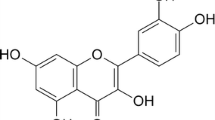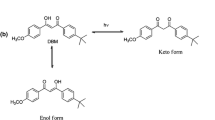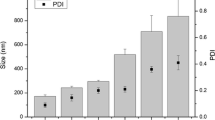Abstract
Quercetin, a plant-derived flavonoid, has been extensively investigated for a wide range of potential health benefits linked to its antioxidant properties. Unfortunately the topical administration of this molecule is restricted by its fast photodegradation. In the attempt to overcome this limitation the inclusion complex between quercetin (Q) and methyl-β-cyclodextrin (Me-β-CD) was prepared and previously investigated by a molecular modelling study, a solubility diagram and a DSC analysis. Successively the kinetics of photodegradation, the antiradical, metal chelating and anti-lipoperoxidative activities were studied by comparing the complex with free Q. In addition the accumulation of Q in porcine skin was evaluated after in vitro topical application by means of vertical Franz cells. The complex formation resulted useful in enhancing the solubility of Q without significantly reducing its antioxidant ability. A modest improvement in the photostability was also observed.










Similar content being viewed by others
References
Halliwell, B., Gutteridge, J.M.: Free radicals, ageing and disease. In: Free Radicals in Biology and Medicine. 2nd edn, pp. 446–493. Clarendon Press, Oxford University Press (1989)
Korkina, L.G., Afanas’ev, I.B.: Antioxidant and chelating properties flavonoids. Adv. Pharmacol. 38, 151–163 (1997)
Ho, C.T., Chen, Q., Shi, H., Zhang, K.Q., Rosen, R.T.: Antioxidative effect of polyphenol extract prepared from various Chinese teas. Prev. Med. 21, 520–525 (1992)
van het Hof, K.H., Wiseman, S.A., Yang, C.S., Tijburg, L.B.M.: Plasma and lipoprotein of tea catechins following repeated tea consumption. Proc. Soc. Exp. Biol. Med. 220, 203–209 (1999)
Pietta, P.G.: Flavonoids as antioxidants. J. Nat. Prod. 63, 1035–1042 (2000)
Beret, A., Cazenave, J.P.: The effect of flavonoids on blood–vessel wall interactions. In: Cody, V., Middleton, E., Harborne, J.B., Beretz, A. (eds.) Plant Flavonoids in Biology and Medicine II: Biochemical, Cellular and Medicinal Properties, pp. 187–200. Alan R. Liss. Inc., New York (1988)
Manthey, J.A., Guthrie, N., Grohmann, R.: Biological properties of citrus flavonoids pertaining to cancer and inflammation. Curr. Med. Chem. 8, 133–153 (2001)
Ohshima, H., Yoshie, Y., Auriol, S., Gilibert, I.: Antioxidant and pro-oxidant actions of flavonoids: effect on DNA (peroxynitrite and nitroxyl anion). Free Radic. Biol. Med. 25, 1057–1065 (1998)
Aviram, M., Fuhrman, B.: Effects of flavonoids on the oxidation of low-density lipoprotein and atherosclerosis. In: Rice-Evans, C.A., Packer, L. (eds.) Flavonoids in Health and Disease, 2nd edn. Revised and Expanded, pp. 165–203. Marcel Dekker Inc., New York (1998)
Kandaswami, C., Middleton, E.: Flavonoids as antioxidants. In: Shahidi, F. (ed.) Natural Antioxidant Chemistry Health Effects and Practical Applications, pp. 174–194. AOCS Press, Champaign, IL (1997)
Rice-Evans, C.A., Miller, N.J., Paganga, G.: Structure-antioxidant activity relationships of flavonoids and phenolic acids. Free Radic. Biol. Med. 20(7), 933–956 (1996)
Sahu, S.C., Green, S.: Food antioxidants: their dual role in carcinogenesis. In: Baskin, S., Salem, H. (eds.) Oxidants, Antioxidant and Free Radicals, pp. 328–330. Taylor and Francis, Washington (1997)
Afanos’ev, B., Dorozhko, A.I., Brodskii, A.V., Kostyuk, A., Potapovitech, A.I.: Chelating and free scavenging mechanism of inhibitory action of rutin and quercetin in lipid peroxidation. Biochem. Pharmacol. 38, 1763–1769 (1989)
Potapovich, A.I., Kostyuk, V.A.: Comparative study of antioxidant properties of cytoprotective activity of flavonoids. Biochemistry (Mosc.) 68, 514–519 (2003)
Tsimogiannis, D.I., Oreopoulou, V.: Free radical scavenging and antioxidant activity of 5,7,3′,4′-hydroxy-substituted flavonoids. IFSET 5, 523–528 (2004)
Jovanovic, S.V., Steenken, S., Hara, Y., Simic, M.G.: Reduction potentials of flavonoids and model phenoxyl radicals which ring in flavonoids is responsible for antioxidant activity? J. Chem. Soc. Perkin Trans. 2, 2497–2504 (1996)
Hendricks, S.B., Borthwick, H.A.: The physiological functions of phytochrome. In: Goodwin, T.W. (ed.) Chemistry and Biochemistry of Plant Pigments, pp. 405–436. Academic Press, London (1965)
Coohill, T.P.: Action spectroscopy: ultraviolet radiation. In: Horspool, W.M., Song, P.S. (eds.) CRC Handbook of Organic Photochemistry and Photobiology, pp. 1267–1275. CRC Press, Boca Raton (1995)
Bouhamidi, R., Prévost, V., Nouvelot, A.: High protection by grape seed proanthocyanidins (GSPC) of polyunsaturated fatty acids against UV-C induced peroxidation. Life Sci. 321, 31–38 (1998)
Greenspan, H.C., Aruoma, O.I.: Oxidative stress and apoptosis in HIV infection: a role for plant-derived metabolites with synergistic antioxidant activity. Immunol. Today 15, 209–213 (1994)
Yuting, C., Rongliang, Z., Zhongjian, J., Yong, J.: Flavonoids as superoxide scavengers and antioxidants. Free Radic. Biol. Med. 9, 19–21 (1990)
Pinelo, M., Manzocco, L., Nunez, M.J., Nicoli, C.: Solvent effect on quercetin antioxidant capacity. Food Chem. 88, 201–207 (2004)
Nicoli, M.C., Calligaris, S., Manzocco, L.: Effect of enzymatic and chemical oxidation on the antioxidant capacity of catechin model systems and apple derivatives. J. Agric. Food Chem. 48, 4576–4580 (2000)
Calabrò, M.L., Tommasini, S., Donato, P., Raneri, D., Stancanelli, R., Ficarra, P., Ficarra, R., Costa, C., Catania, S., Rustichelli, C., Gamberini, G.: Effects of α- and β-cyclodextrin complexation on the physico-chemical properties and antioxidant activity of some 3-hydroxyflavones. J. Pharm. Biomed. Anal. 35, 365–377 (2004)
Ficarra, R., Ficarra, P., Tommasini, S., Campagna, S., Guglielmo, O.: Photochemistry of flavonoids solvent effect on photochemical behaviour of 3-hydroxyflavone. Boll. Chim. Farm. 133, 665–669 (1994)
Falkovskaia, E., Sengupta, P.K., Kasha, M.: Photophysical induction of dual fluorescence of quercetin and related hydroxyflavones upon intermolecular H-bonding to solvent matrix. Chem. Phys. Lett. 297, 109–116 (1998)
Rezende, B.A., Cortes, S.F., De Sousa, F.B., Lula, I.S., Schmitt, M., Sinisterra, R.D., Lemos, V.S.: Complexation with β-cyclodextrin confers oral activity on the flavonoid dioclein. Int. J. Pharm. 367, 133–139 (2009)
Alvarez-Parrilla, E., De La Rosa, L.A., Torres-Riva, F., Rodrigo-García, J., González-Aguilar, G.A.: Complexation of apple antioxidants: chlorogenic acid, quercetin and rutin by β-cyclodextrins. J. Incl. Phenom. Macrocycl. Chem. 53, 121–129 (2005)
Loftsson, T., Brewster, M.E.: Pharmaceutical applications of cyclodextrins. Drug solubilization and stabilization. J. Pharm. Sci. 85, 1017–1025 (1986)
Mielcarek, J.: Photochemical stability of the inclusion complexes formed by modified 1,4-dihydropyridine derivatives with β-cyclodextrin. J. Pharm. Biomed. Anal. 15, 681–686 (1997)
Sortino, S., Scaiano, J.C., De Guidi, G., Monti, S.: Effect of β-cyclodextrin complexation on the photochemical and photosensitizing properties of tolmetin: a steady state and time resolved study. Photochem. Photobiol. 70, 549–556 (1999)
Scalia, S., Villani, S., Casolari, A.: Inclusion complexation of the sunscreen agent 2-ethylhexyl-p-dimethylaminobenzoate with hydroxypropyl-β-cyclodextrin: effect on photostability. J. Pharm. Pharmacol. 51, 1367–1374 (1999)
Albini, A., Fasani, E.: Photochemistry of drugs: an overview and practical problems. In: Albini, A., Fasani, E. (eds.) Drugs: photochemistry and photostability, pp. 1–74. The Royal Society of Chemistry, Cambridge, UK (1998)
Tommasini, S., Calabrò, M.L., Donato, P., Raneri, D., Guglielmo, G., Ficarra, P., Ficarra, R.: Comparative photodegradation studies on 3-hydroxyflavone: influence of different media, pH and light sources. J. Pharm. Biomed. Anal. 35, 389–397 (2004)
Lucas-Abellán, C., Fortea, I., Gabaldón, J.A., Núñez-Delicado, E.: Encapsulation of quercetin and myricetin in cyclodextrins at acidic pH. J. Agric. Food Chem. 56, 255–259 (2008)
Yu, Z., Cui, M., Yan, C., Song, F., Liu, Z., Liu, S.: Investigation of heptakis (2,6-di-O-methyl)-β-cyclodextrin inclusion complexes with flavonoid glycosides by electrospray ionization mass spectrometry. Rapid Commun. Mass Spectrom. 21, 683–690 (2007)
Jullian, C., Moyano, L., Yañez, C., Olea-Azar, C.: Complexation of quercetin with three kinds of cyclodextrins: an antioxidant study. Spectrochim. Acta A 67, 230–234 (2007)
Kim, H., Choi, J., Jung, S.: Inclusion complexes of modified cyclodextrins with some flavonols. J. Incl. Phenom. Macrocycl. Chem. 64, 43–47 (2009)
MOE: version 2008.10, Chemical Computing Group, Montreal, QC, Canada. http://www.chemcomp.com/ (2008)
Sapino, S., Trotta, M., Ermondi, G., Caron, G., Cavalli, R., Carlotti, M.E.: On the complexation of trolox with methyl-β-cyclodextrin: characterization, molecular modelling and photostabilizing properties. J. Incl. Phenom. Macrocycl. Chem. 62, 179–186 (2008)
Higuchi, T., Connors, A.: Phase solubility techniques. Adv. Anal. Chem. Instrum. 4, 117–212 (1965)
Brand-Williams, W., Cuvelier, M.E., Berset, C.: Use of a free radical method to evaluate antioxidant activity. Food Sci. Technol. 28, 25–30 (1995)
Jang, S., Xu, Z.: Lipophilic and hydrophilic antioxidants and their antioxidant activities in purple rice bran. J. Agric. Food Chem. 57, 858–862 (2009)
Bay, B.-H., Lee, Y.-K., Tan, B.K.-H., Ling, E.-A.: Lipid peroxidative stress and antioxidative enzymes in brains of milk-supplemented rats. Neurosci. Lett. 277, 127–133 (1999)
Sapino, S., Carlotti, M.E., Caron, G., Ugazio, E., Cavalli, R.: In silico design, photostability and biological properties of the complex resveratrol/hydroxypropyl-β-cyclodextrin. J. Incl. Phenom. Macrocycl. Chem. 63, 171–180 (2009)
Christoff, M., Toscano, V.G., Baader, W.J.: Influence of methoxy substitution on flavonoid photophysics: a steady state and laser flash photolysis study. J. Photochem. Photobiol. A Chem. 101, 11–20 (1996)
Smith, G.J., Thomsen, S.J., Markham, K.R., Andary, C., Cardon, D.: The photostabilities of natural occurring 5-hydroxyflavone, flavonols, their glycosides and their aluminium complex. J. Photochem. Photobiol. A Chem. 136, 87–91 (2000)
Bayomi, M.A., Abanumay, K.A., Al-Angary, A.A.: Effect of inclusion complexation with cyclodextrins on photostability of nifedipine in solid state. Int. J. Pharm. 243, 107–117 (2002)
Godwin, D.A., Wiley, C.J., Felton, L.A.: Using cyclodextrin complexation to enhance secondary photoprotection of topically applied ibuprofen. Eur. J. Pharm. Biopharm. 62, 85–93 (2006)
Carlotti, M.E., Sapino, S., Vione, D., Pelizzetti, E., Trotta, M.: Photostability of trolox in water/ethanol, water and Oramix CG110, in the absence and in the presence of TiO2. J. Dispers. Sci. Technol. 25, 193–207 (2004)
Carlotti, M.E., Sapino, S., Vione, D., Minero, C., Peira, E., Trotta, M.: Study on the photodegradation of salicylic acid in different vehicles in the absence and in the presence of TiO2. J. Dispers. Sci. Technol. 28, 805–818 (2007)
Murias, M., Jäger, W., Handler, N., Erker, T., Horvath, Z., Szekeres, T., Nohl, H., Gille, L.: Antioxidant, prooxidant and cytotoxic activity of hydroxylated resveratrol analogues: structure–activity relationship. Biochem. Pharmacol. 69, 903–912 (1995)
Goldstein, S., Meyerstein, D., Czapski, G.: The Fenton reagents. Free Radic. Biol. Med. 15, 435–445 (1993)
Gülçin, I.: Antioxidant activity of caffeic acid (3,4-dihydroxycinnamic acid). Toxicology 217, 213–220 (2006)
Diembeck, W., Beck, H., Benech-Kieffer, F., Courtellemont, P., Dupuis, J., Lowell, W., Paye, M., Spengler, M., Steiling, W.: Test guidelines for in vitro assessment of dermal absorption and percutaneous penetration of cosmetic ingredients. Food Chem. Toxicol. 37, 191–205 (1999)
Loftsson, T., Stefánsson, E.: Effect of cyclodextrins on topical drug delivery to the eye. Drug Dev. Ind. Pharm. 23, 473–481 (1997)
Carlotti, M.E., Ugazio, E., Gastaldi, L., Sapino, S., Vione, D., Fenoglio, I., Fubini, B.: Specific effects of single antioxidants in the lipid peroxidation caused by nano-titania used in sunscreen lotions. J. Photochem. Photobiol. B Biol. 96, 130–135 (2009)
Carlotti, M.E., Ugazio, E., Sapino, S., Fenoglio, I., Greco, G., Fubini, B.: Role of particle coating in controlling skin damage photoinduced by titania nanoparticles. Free Radic. Res. 43, 312–322 (2009)
Jacobi, U., Kaiser, M., Toll, R., Mangelsdorf, S., Audring, H., Otberg, N., Sterry, W., Lademann, J.: Porcine ear skin: an in vitro model for human skin. Skin Res. Technol. 13, 19–24 (2007)
Author information
Authors and Affiliations
Corresponding author
Rights and permissions
About this article
Cite this article
Carlotti, M.E., Sapino, S., Ugazio, E. et al. On the complexation of quercetin with methyl-β-cyclodextrin: photostability and antioxidant studies. J Incl Phenom Macrocycl Chem 70, 81–90 (2011). https://doi.org/10.1007/s10847-010-9864-7
Received:
Accepted:
Published:
Issue Date:
DOI: https://doi.org/10.1007/s10847-010-9864-7




